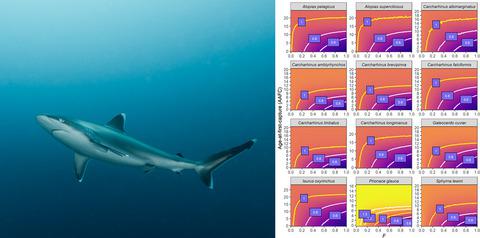当前位置:
X-MOL 学术
›
J. Appl. Ecol.
›
论文详情
Our official English website, www.x-mol.net, welcomes your
feedback! (Note: you will need to create a separate account there.)
Can multi‐species shark longline fisheries be managed sustainably using size limits? Theoretically, yes. Realistically, no
Journal of Applied Ecology ( IF 5.0 ) Pub Date : 2020-07-15 , DOI: 10.1111/1365-2664.13659 Jonathan J. Smart 1, 2 , William T. White 3, 4 , Leontine Baje 5, 6 , Andrew Chin 5 , Brooke M. D'Alberto 3, 5 , Michael I. Grant 5 , Sushmita Mukherji 5 , Colin A. Simpfendorfer 5
中文翻译:

可以使用规模限制来可持续管理多物种鲨鱼延绳钓渔业吗?从理论上讲,是的。实际上,没有
更新日期:2020-07-15
Journal of Applied Ecology ( IF 5.0 ) Pub Date : 2020-07-15 , DOI: 10.1111/1365-2664.13659 Jonathan J. Smart 1, 2 , William T. White 3, 4 , Leontine Baje 5, 6 , Andrew Chin 5 , Brooke M. D'Alberto 3, 5 , Michael I. Grant 5 , Sushmita Mukherji 5 , Colin A. Simpfendorfer 5
Affiliation

|
- Size limits are a common fisheries management strategy that are applied to many fisheries and species. Most size limits use a minimum legal size to protect adult fish as per the ‘reproduce at least once’ paradigm, where stock collapse becomes impossible if every adult can produce one spawner prior to harvest. These approaches can be useful in fisheries where determining catch is difficult and therefore catch limits can be ineffective and potentially cause stock decline.
- Shark longline fisheries can be complicated to manage due to a deficiency of species‐level reporting. Catch limits are therefore difficult to determine, creating a need for other management measures. Here, three different size‐based management approaches were tested using the shark longline fishery from Papua New Guinea as a case study. These approaches included minimum size, maximum size and harvest slot approaches.
- Age‐structured Leslie matrix models revealed a broad range of productivities for 12 commonly caught species, ranging from low population growth rates of 1% per year for pelagic thresher sharks Alopias pelagicus to >33% per year for blue sharks Prionace glauca. Therefore, different harvest strategies were required for each species to be fished sustainably. However, management could be applied by grouping similar and easily distinguishable groups of species together.
- Synthesis and applications. The most pragmatic harvest strategy for all shark species included in this study was to limit harvest to mature individuals using minimum legal sizes. This provided sufficient resilience for all species to tolerate higher levels of fishing mortality than the Papua New Guinea (PNG) longline fishery could impose. Legal minimum lengths were derived from the largest length‐at‐maturity within each species group. However, while this produced a sustainable harvest strategy, issues with selectivity, post‐release mortality, interactions with other fisheries, economic viability and illegal, underreported and unregulated fishing were challenges to restricting fishing to the correct size classes and overall management efficacy. Therefore, while theoretically viable harvest strategies were outlined, it is apparent that size limits would not ensure that these shark species are fished sustainably. Therefore, the PNG longline fishery cannot operate sustainably if it were to reopen using size limits as its sole management strategy.
中文翻译:

可以使用规模限制来可持续管理多物种鲨鱼延绳钓渔业吗?从理论上讲,是的。实际上,没有
- 规模限制是一种普遍的渔业管理策略,适用于许多渔业和物种。根据“至少繁殖一次”的范例,大多数规格限制使用最小的法定尺寸来保护成年鱼类,如果每个成年虾在捕捞前都可以生产一个产卵者,则种群崩溃是不可能的。这些方法在难以确定渔获量的渔业中很有用,因此渔获量限制可能无效,并可能导致种群减少。
- 由于缺乏物种一级的报告,鲨鱼延绳钓渔业的管理可能很复杂。因此,捕捞限量很难确定,因此需要其他管理措施。在此,以来自巴布亚新几内亚的鲨鱼延绳钓渔业为例,对三种不同的规模管理方法进行了测试。这些方法包括最小尺寸,最大尺寸和收获槽方法。
- 年龄结构的莱斯利矩阵模型揭示了12种常见捕获物种的广泛生产力,范围从中上层脱粒器鲨Alopias pelagicus的低种群增长率每年1%到蓝鲨Prionace glauca的每年33%以上的低增长率。因此,要可持续地捕捞每个物种需要不同的收获策略。但是,可以通过将相似且易于区分的物种分组在一起来应用管理。
- 综合与应用。本研究中所有鲨鱼种类最务实的收获策略是使用最小合法尺寸将收获限制在成熟个体上。与巴布亚新几内亚(PNG)延绳钓渔业所能施加的抵抗力相比,这为所有物种提供了足够的弹性来承受更高的捕捞死亡率。法定最小长度是根据每个物种组中最大的成熟长度得出的。然而,尽管这产生了可持续的捕捞战略,但选择性,释放后的死亡率,与其他渔业的相互作用,经济生存能力以及非法,低报和无管制的捕捞等问题仍然是限制将捕捞限制在正确规模和总体管理效力的挑战。因此,尽管概述了理论上可行的收获策略,显然,大小限制不能确保这些鲨鱼物种得到可持续的捕捞。因此,如果将尺寸限制作为唯一管理策略重新开放,PNG延绳钓渔业将无法持续运作。











































 京公网安备 11010802027423号
京公网安备 11010802027423号